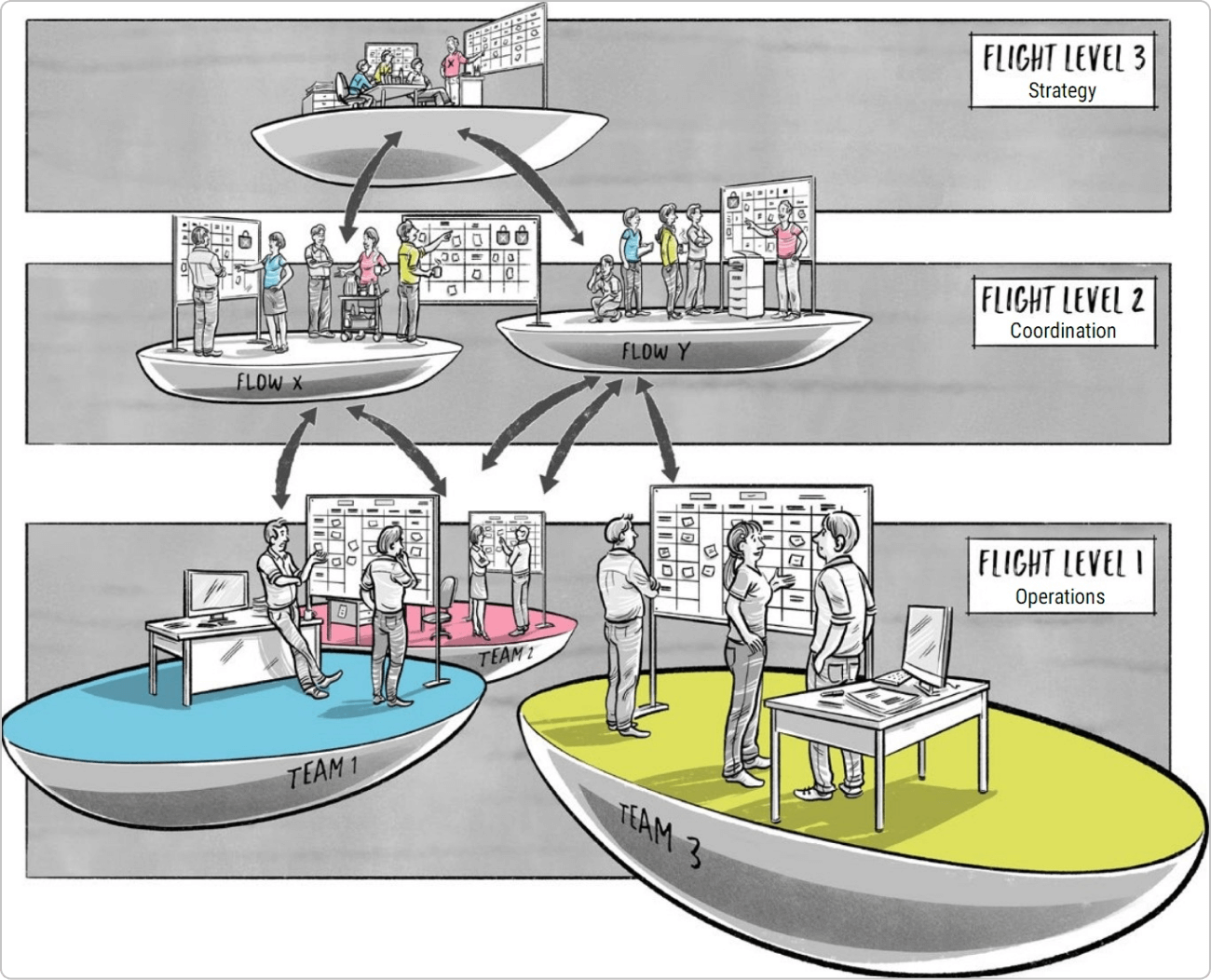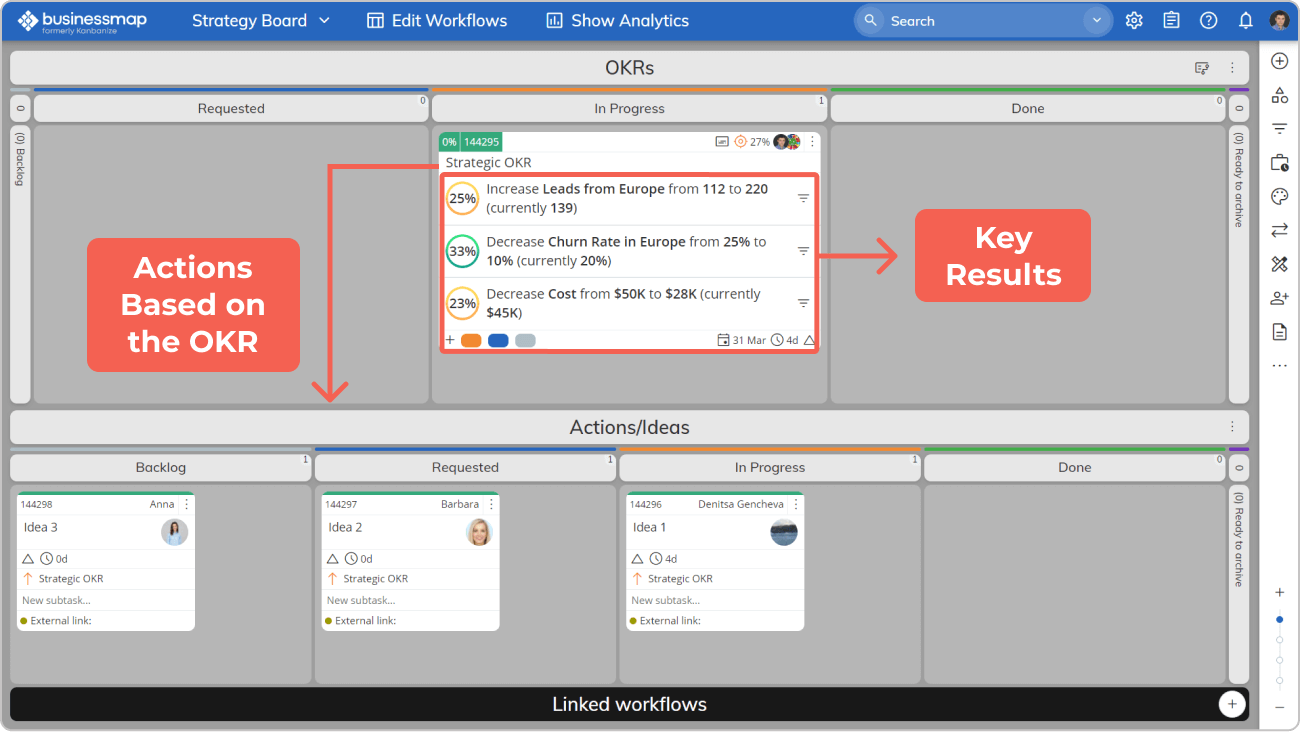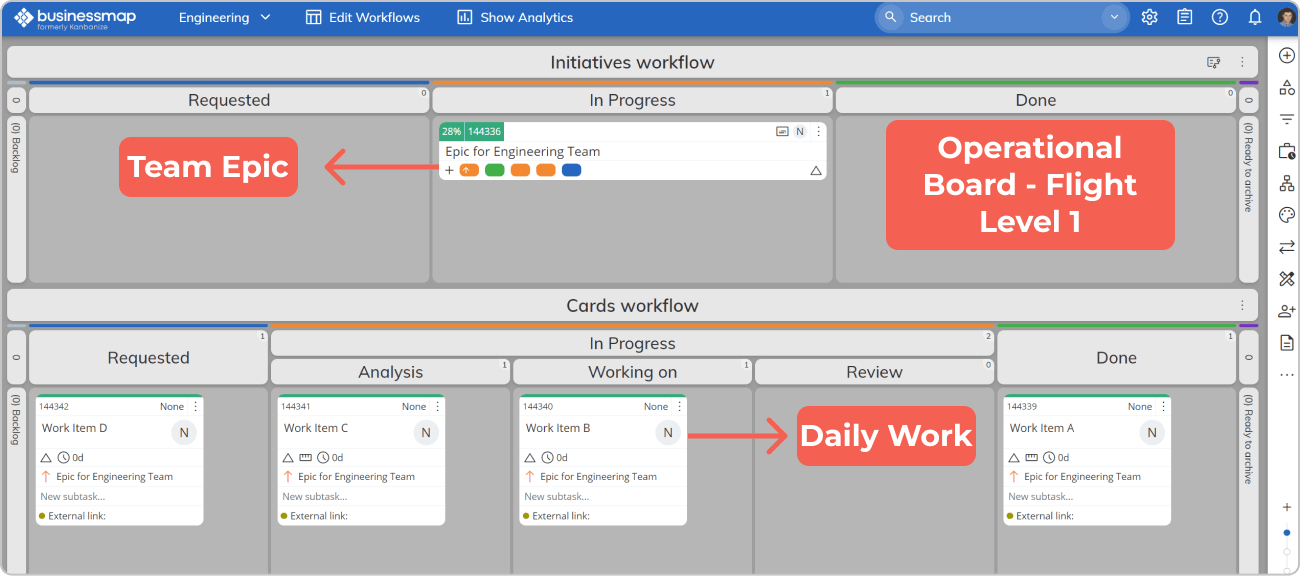“Strategy execution is the responsibility that makes or breaks executives”!
After spending several years in the project management space, this is one of the quotes that have shaped my understanding of agility. I’ve learned that being Agile is not just about delivering faster. Instead, it’s about making decisions faster.
Аfter all, what’s the point of delivering faster if you’re going in the wrong direction?
That’s why you need to make your strategy flow across the organization by creating a holistic connection between your ideas and their execution.
To do that, one of my favorite approaches is the Flight Levels concept. It’s straightforward yet powerful.
And in this article, we will uncover it in more detail.
How An Organization Resembles Flying? Flight Levels Explained.
Flight Levels is a business agility concept developed by Klaus Leopold, which emphasizes 3 organizational levels:
Level 1 – Operational
Level 2 – Value Stream/Coordination
Level 3 – Strategic

Image credit: https://www.flowsphere.ch/en/
To make the concept clearer, I use the following analogy.
Imagine that you’re flying in a helicopter. By default, helicopters can’t reach too high of an altitude, so you can comfortably see trees, cars, and even people from above. In an organizational context, you can think of it as the team management or operational level, where you have an overview of specific tasks, workflows, and policies.
That’s Flight Level 1.
On the other hand, imagine you’re in a small plane that can fly high enough, so you can’t see very specific details (such as cars). However, it’s still low enough for you to see mountains or even high buildings. In an organization, you can think of that as the value stream that coordinates multiple teams and delivers what the customer is paying for.
That’s Flight Level 2.
And lastly, think of flying in a big commercial plane. What’s visible are usually only seas and islands as you’re passing over them. In a company, this represents the strategy that guides the direction of the business.
That’s Flight Level 3.
So, What Do These Flight Levels Represent?
Each one of these levels represents different goals that the organization has for propelling the business forward.
At flight level 3, you’re concerned with defining your company’s direction based on the broader strategy. To do this, you can implement OKRs and create a backlog of actionable ideas that support them.
At flight level 2, the focus shifts to the value stream.
Here it’s about tracking the flow of an idea from a rough concept to actual value with the goal of shortening the entire customer lead time. From our experience, limiting WIP is more valuable here than applying the practice at the team level. By focusing on a few high-level projects at a time, you can work more efficiently and accomplish more.
Going further down to flight level 1, your attention moves to the operational environment where team leaders are concerned with more detailed performances. For example, the cycle time of individual teams which reflects the lead time of the entire value stream.
The Flight Levels approach doesn’t specify how teams should execute their work. Regardless of whether you’re using iterations or continuous flow, the goal is to optimize individual work systems so you can shorten the entire product/service delivery time.
How to Bring Flight Levels into Practice? Learn from Our Approach at Businessmap.
As we talk to customers about achieving organizational agility through Flight Levels, their ears perk up. But everybody wants to see it in practice, so they can visualize what’s possible in their mind.
That’s what I will attempt to do next, starting from the highest Flight Level – 3.
Implement Your Ideas with OKRs & Strategic Boards (Flight Level 3)
If you’re not familiar with the Businessmap platform, we use Management and Team workspaces to help companies visualize all their work initiatives – from top-level goals to daily work activities. Within every Management workspace, you can create Management boards that can consolidate multiple Management or Team boards together. That’s how we aim to bring full-blown transparency inside the organization across different hierarchical levels.

So, to visualize Flight Level 3 in the platform, let’s create a Management workspace with a top-level Management board and call it “Strategy board”. As you’re concerned with creating strategic goals here, you can separate its workflows into “OKRs” and “Actions/Ideas”.

Keep in mind that to implement OKRs in Businessmap, every initiative can contain outcomes that guide the work execution. In other words, you can think of the initiative as your objective and the outcomes as your key results.

Having said that, let’s imagine the following structure.
You have a “Strategic OKR” with 3 outcomes, and you’ve broken it down into more actionable ideas in the backlog area of the “Actions/Ideas” workflow. Keep in mind that those ideas may or may not be executed.

This brings us to the second Flight Level.
Value Stream Mapping & Coordination (Flight Level 2)
With the strategy board in place, you can turn your attention to managing the value stream and coordinating the execution of projects across teams. That’s what Flight Level 2 is concerned with.
The Management board in Businessmap is pretty unique. As we mentioned, you can link both other Management or Team boards to it and create a complete hierarchical visualization in your company.
In this case, let’s create the value stream map inside another Management board which will be linked to the Strategy board. The difference here will be that this Management board will contain team boards connected to it.

Without going into heavy details, the concept is to have a central place where the value stream map has a connection to both your strategy and the operational level. The goal is to feed the value stream with ideas (derived from Flight Level 3) that go through concept/analysis to define whether they should turn into projects.

You can then break down those projects into smaller initiatives for the teams supporting this value stream. At this level, we recommend holding Operational Reviews to manage dependencies between teams and applying WIP limits to optimize the flow of value to the customer.
Creating a Network of Interdependent Teams (Flight Level 1)
Moving further down the levels, it’s time to look at the operational side of the structure where the work happens.
Every team inside the value stream Management board has its own team board. In Businessmap, every team board can have workflows for team epics and daily work. Unlike the Management board, the team board’s focus is specifically on the epic and task level.

Think of the operational structure as the engine that moves the entire hierarchy forward.
As daily tasks are completed, the progress on epics is increasing, which reflects the project's progress on the value stream level. In turn, this moves the entire strategic OKR forward.
How To Get Started with Flight Levels in Your Company?
Before we end this article, it’s important to make clear that the Flight Levels approach doesn’t require disruptions in your organizational structure. Based on your own environment, different Flight Levels could be mixed up together.
For example, it’s common for an enterprise to have multiple value streams based on a portfolio of products or services they offer. As a result, they can connect Flight Level 3 & Flight Level 2 boards in a single environment to combine the management of top-level OKRs and certain parts of a value stream.
But even though important, the structure is not the most crucial thing here.
Instead, try to understand the Flight Levels concept and how it enables strategic flow inside the organization. Think of it as creating a flight wheel that constantly maintains your strategic execution and provides management with data about operational challenges. This helps you make decisions faster, so you can pivot your strategy when necessary.
After all, that’s what business agility is all about.

Nikolay Tsonev
Product Marketing | PMI Agile | SAFe Agilist certified
Nick is passionate about product marketing and business development and is a subject matter expert at Businessmap. With expertise in OKRs, strategy execution, Agile, and Kanban, he continues to drive his interest in continuous improvement. Nick is a PMI Agile and SAFe Agilist certified practitioner.



